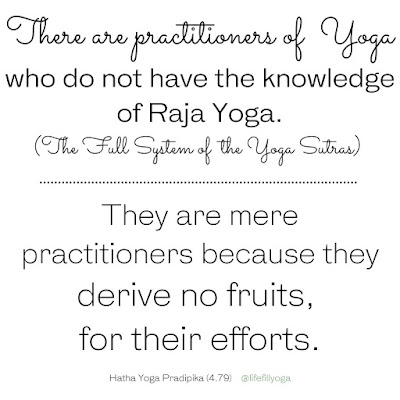Hatha Yoga Pradipika Chapter 1 Conclusion
Do Hatha Yoga to Prepare for Raja Yoga
Verse/Sloka 1.67
"The various types of Kumbhakas (breath retentions), the many Karanas (actions like the Asanas), and other various means of illumination should all be practiced in the Hatha Yoga System until the fruit of Raja Yoga is attained.
In Sanskrit:
Commentary
What is Raja Yoga?
Samadhi pada: Defines yoga
Sadhana pada: Describes the Eight Limb Path of Yoga
Vibhuta pada: Describes and also warns against the temptations of the eight siddhis
Kaivalya pada: Describes how to live in the world beyond the influences of the three Gunas
(Sattva, Rajas, and Tamas). We' ve seen that this is a large part of Hatha Yoga, the balancing of the Gunas.
Often when people think of Raja Yoga or the Yoga of the Yoga Sutras, they think of the 8 Limb path.
The 8 Limb Path
1. Yama -- Ways of Living -- (I like this translation over ethics or morals. "Yama (यम, “forbearance”) is a Sanskrit word referring to “respect for others”" 1
- Ahimsa: the opposite of violence.
- Satya: Be truth.
- Asteya: the opposite of stealing.
- Brahmacharya: walking in the way of the divine.
- Aparigraha: the opposite of hoarding.
- Non-violence, Ahimsa
- truth, satyam
- non-stealing, asteyam
- continence (being absorbed in a pure state of consciousness),brahmacharyam
- forgiveness, kshama
- endurance, dhrtih
- compassion, daya
- humility, arjavam
- moderate/ pleasant diet mitaharah
- and cleanliness saucham
2. Niyama -- Self-care-- Niyama means Niyama (नियम, “religious restraint”) is a Sanskrit word referring to “respect for yourself”.1
- Saucha: Cleanliness.
- Santosha: Contentment.
- Tapas: Self-discipline.
- Svadhyaya: Self-study.
- Ishvara pranidhana: Surrender to the Divine.
- Self-discipline, Penance, Austerity, Tapah
- contentment, santosha
- belief (faith) in the Supreme (God), astikyam
- charity, dana
- worship of God, isvarapujanam
- listening to the recitations of sacred scriptures, siddhantavakyasravanam
- modesty, hri
- a discerning intellect, mati
- (mantra repetition) japa [connected to tapo (ascetic)?]
- and sacrifice -- Hutam
4. Pranayama
Breath Expansion. Often translated as Breath Work. It means Pra+na+ Ayama (Life Force+ the opposite of restraint. Iyengar defined it as Breath Expansion). We will cover the Hatha Yoga Pradipika versions of Pranayama soon. According to Hatha Yoga Pradipika, before Pranayama, Purifications or Shatkarma is practiced if necessary (more of that next)
5. Pratyahara
Pratyahara is the practice of sensory withdrawal.
6. Dharana
Dharana means concentration.
7. Dhyana
Dhyana is meditation.
8. Samadhi
Samadhi comes through sustained meditation or absorption and is the goal of Yoga.
"Salutations to the glorious primal (original) guru, Sri Adinath, who instructed the knowledge of Hatha Yoga which shines forth as a stairway for those who wish to ascend to the Highest stage of Yoga, Raja Yoga."
So, in order to practice the full system of Yoga and attain its benefits, its fruits, we are called to learn both the preparation, the Hatha Yoga of the Hatha Yoga Pradipika and have knowledge of the Raja Yoga of the Yoga Sutras.
What benefits have you found in Yoga? What benefits do you seek?
Resources:









No comments:
Post a Comment